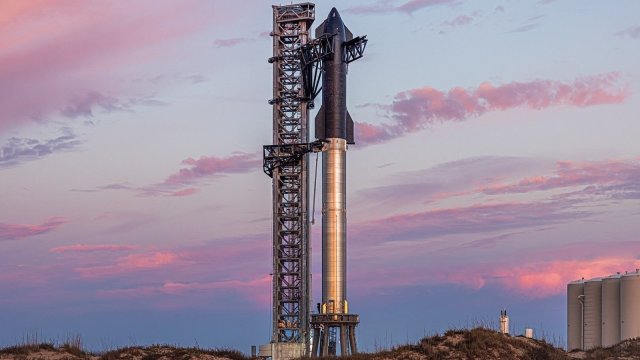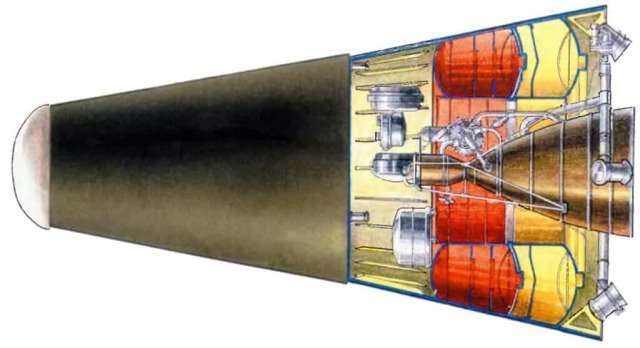The first flight of the heaviest rocket in history is expected in the very near future. Elon Musk recently announced that the tests should be conducted in April. How will the first test launch take place, what does it consist of? Naked Science analyzes in detail the planned flight situations for you.
Flight diagram of the upcoming launch
The scenario of the future test is both understandable and peculiar. Here are its key stages: launch, landing of an empty first stage, entering a low reference orbit, performing almost a full turn on it, braking with the transition to landing and landing on water. The flight scheme combines solutions worked out at different times, and completely new elements performed for the first time. All this makes the upcoming test very interesting, and its outcome unpredictable.
The launch of a carrier of record mass and size will be carried out from the launch complex of the orbital launch pad based on SpaceX's Starbase on the coast of the Gulf of Mexico, Boca Chica, Texas, USA. This launch will also be the first test of the launch device. The flight after the start is unlikely to be unusual before the separation of the stages (170 seconds after the start, the motion parameters during separation are unknown). After it, the first stage of the Super Heavy will land and land in the water of the Gulf of Mexico.
Starship will continue to accelerate and climb until entering a circular low reference orbit. The azimuth of the launch is planned to be about 100-110 degrees, which will give a slight inclination of the orbit. The route, its ground projection, will pass to the east-southeast between Florida and Cuba, then descending to the equator, skirting the southern hemisphere and rising back to the northern. Completing the turn, the Starship will approach from the northeast to the landing area. After the braking impulse, it will decrease and descend in the atmosphere to the place of flooding, located in the ocean 100 kilometers northwest of the island of Kauai, the northernmost island of the Hawaiian archipelago.
The flight scheme is generally clear, but the details are mostly unknown: neither the range, speed, overload, altitude, nor the details of the structures. The reasons and logic of the choice of solutions, if they are not explained by the creators, remain only our guesses. In addition, new information still pops up from time to time, clarifying or changing the details of the picture. Since no one, including us, has accurate and reliable data, we want to look from different angles at the upcoming test work without absolute statements and unambiguous assessments.
Is the orbit an orbit if the circle is not closed?
Discussions begin already with whether the orbital section of the Starship test flight is a full-fledged orbit at all, if there is no full revolution. From the point of view of flight dynamics, it does not matter how much time or kilometers the device flew in orbit, whether it is enough for the test. The state of the orbital motion is important — it determines whether the device is moving in orbit, and by which one. The practice of space flights for a good half consists of cases of incomplete orbit rotation. For example, such cases include the use of low reference orbits. The reference orbit is the one occupied to move from it to another at the right moment. Their usual height in Russia is round 200 kilometers, in the USA 185 kilometers (round 100 miles). Among all the working orbits here, the flight speed is the highest, and the density of the atmosphere (the density of the atmosphere is even higher below — but the orbits are already unstable), so aerodynamic braking is noticeable.
There is often no point in making a full turn here — after it, the local ballistic situation usually repeats: again the same points of orbit, altitude and speed. They do not make a turn on the transition orbits between the initial and target orbits — the transition itself is enough. Geostationary orbits are used to enter geostationary orbit without a full orbit. These are the reference orbits along which they reach the next engine start, which forms the necessary ellipse of the transition orbit from this point: for example, you just need to shift from the equator to the pole in a quarter of a revolution to reach a given geographical engine start point. InSight was launched to Mars for the first time from a polar orbit. As a reference, he followed it from Vanderberg in California south to Antarctica and the Centauri polar second inclusion there to switch to a hyperbolic trajectory. InSight also made its further flight to Mars without a full orbit around the Sun, but only before meeting Mars.
It is the state of motion in orbit that is of interest — it makes it possible to check flight control and the operation of systems in zero gravity. The latter can be "obtained" on a suborbital trajectory, but it will not work out the full energy of the orbital launch. Suddenly, at a speed of 7.8 kilometers per second, just before entering orbit and reaching the first space speed, something turns out to be wrong? And suborbital speeds are lower. And then the flight mode in the range between suborbital and orbital speed will remain untested.
Similar flights half a century ago
A close ballistic analogue of the upcoming Starship test was the flights of the R-36orb rocket, index 8K69. This combat missile was formally part of the intercontinental type and put the head unit into low Earth orbit. The head of the 8F021 was the only one of its kind: both combat and orbital; and the rocket itself, thus, the only combat carrier rocket.
Contrary to popular belief, the head part of the R-36orb was not based in orbit. This is irrational, because the orbit cannot be quickly rotated in space so that its route quickly passes through the ground point of the target. With orbital basing, the expectation of the passage of the head part to the target can be up to one period of rotation (if the head part has already passed the target, leaving it behind) — that is, up to an hour and a half. Which is not as fast as a 30-50-minute flight of an intercontinental missile.
The R-36orb missile was launched from a combat launch position directly during the strike, like a conventional combat missile. The output of the head unit to a low reference orbit — a combat orbit — made it possible to extend its path to the opposite point of the Earth. Further, in general, it is not worth it, then the target will already be closer, but on the other hand; it is easier to change the azimuth of the launch by 180 degrees, reducing the flight time. The orbital velocity is greater than the suborbital ones, so the orbital warhead will reach the target faster than conventional warheads, and with increasing range this gain will be greater. To accelerate to orbital speed, the mass of the head part was limited to 1,700 kilograms.
The uncertainty of the point of departure from orbit (the moment of time and the magnitude of the braking pulse) does not allow us to predict the area of fall from this orbit, as it can be done using a conventional ballistic trajectory. It is also possible to fly along a long trajectory with more than half a turn: with entry into the territory of a likely enemy from the weak protection of the target, from the direction of Antarctica, for example. But such a long route will also give a long flight time with a possible debatable combat win.
After entering orbit, the head part of the R-36orb functioned as an orbiting spacecraft. In addition to the warhead (a thermonuclear charge with a control unit), there was an inertial flight control system on board, with orientation and stabilization subsystems. In addition to it, the current altitude was changed by a radio altimeter at the beginning and end of the orbital section. According to the measured data, the braking impulse and the operating time of the propulsion system, which was part of the brake stage of the head part, were calculated.
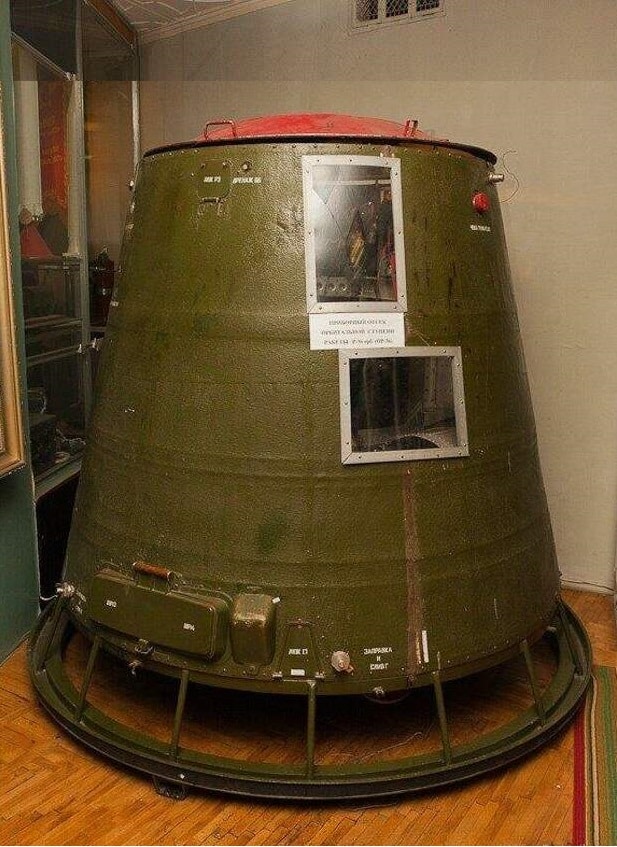 |
| The body of the braking stage 8F673 of the orbital head part 8F021 of the R-36orb rocket. |
| Source: Vk.com |
Approaching the target area, she left the reference orbit, "not up, but down" (A. Makarevich). The engine was turned forward and a braking pulse was issued, which transferred the head part to a suborbital trajectory with a perigee deep underground and a point of intersection of the surface in the target area. After that, there was a ballistic entry into the atmosphere, like a conventional intercontinental missile.
The R-36orb rocket began test flights in December 1965, 58 years ago. After three years of flight tests (four emergency launches, 15 successful ones — a typical pattern for testing any representatives of the R-36 family), the missile system was adopted. He was on combat duty until 1983, from which he was removed 40 years ago in accordance with the Strategic Arms Limitation Treaty OSV-2. Thus, the flight scheme of the R-36orb is a very close analogue of the upcoming Starship flight with its single and possibly incomplete rotation in a low reference orbit. There can be a noticeable difference only in terms of entering the atmosphere with its aerodynamics. Here, the Space Shuttle orbiter can intercept the relay of analogues in the upper parts of the atmosphere, and in the lower hypersonic and supersonic mode, the experimental X-15.
Descent and deceleration in the atmosphere
Supersonic Starship-sized vehicles did not fly in the upper stratosphere and in hypersonic modes. The length-span-mass (meters-meters-tons) of the Starship is 50-18-250. The shuttle, for example, with its 37-24-86, was shorter and lighter. And the Tu-160 with its 54-36-250 flew only at supersonic speed in the lower stratosphere. From the point of view of hypersonic shape features, Starship has nothing new, it is a cylinder with an ogival shape fairing. This shape repeats the well-flown (199 flights with measurements) body of the experimental X-15, with a close geometry and contours of the nose.
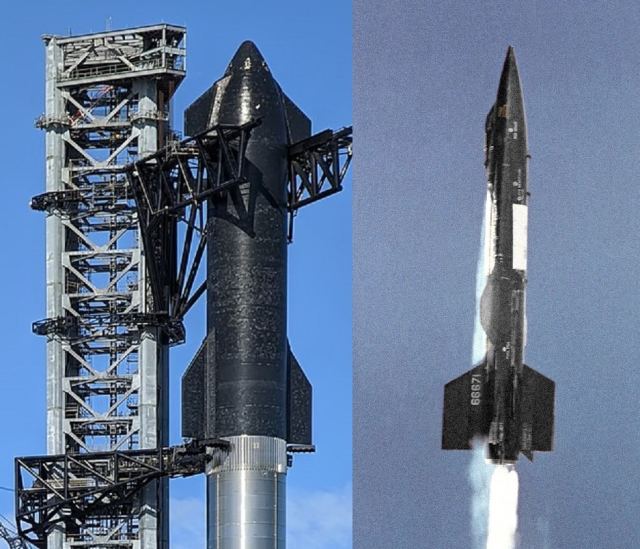 |
| Comparison of the form of Starship and X-15, collage. |
| Source: ©Nikolay Tsygikalo |
It is quite possible that Musk took for Starship not only the geometry of its hull, but also elements of supersonic and hypersonic aerodynamics. It is no coincidence that the rear wings of the Starship are similar in shape to the vertical tail fins of the X-15, maximally adapted to hypersonic. Such a choice of similarity with the already known hull and keels increases the reliability of the solution and saves time and costs for testing: this form has already been flown in two hundred test flights. With complete and reliable data, in various supersonic and hypersonic modes and flight conditions.
A hypersonic section would be interesting in detail. The shuttle, for example, entered the atmosphere with its bottom across the stream. In this orientation, the first hypersonic flow occurred, with values of the Mach number level 20 and higher. Although the temperature of the compressed stream on the bottom reached thousands of degrees, it was still too loose and did not burn. After all, burning is not a consequence of the temperature itself alone, but to a greater extent of the heat flow. The latter is created by the substance of hot compressed gas: the more hot matter (and heat) in a cubic centimeter, the stronger this cubic centimeter of matter warms, and with increasing temperature and shines.
Due to the strong initial rarefaction of the air, even its compression by orders of magnitude in the shock wave (it is she who tightly wraps the bottom, arising on it and sticking to it) does not make the compressed stream very dense, albeit hot. Here, temperatures close to the temperature of complete deceleration of the flow are realized — the temperature of the stopped gas, all the energy of movement of which would be transferred to compression and heating.
But the heat flow in the bottom is still small, as is the achieved density. The pressure of compressed air on the bottom at such a density is also still small. But with a large area of the bottom and wing, its efforts can be collected into a growing force of aerodynamic drag. So the force effect of the flow appears earlier than the temperature effect. Simply put, the flow begins to press earlier than it burns.
This initial braking in the upper layers is rationally used by any entry systems. And Starship will probably enter the atmosphere across the speed according to the "shuttle" scheme. Its body and wings are plastered with hexagons of heat—protective tiles from bottom to top - enough to transfer frying in any angle of blowing with a hypersonic flow.
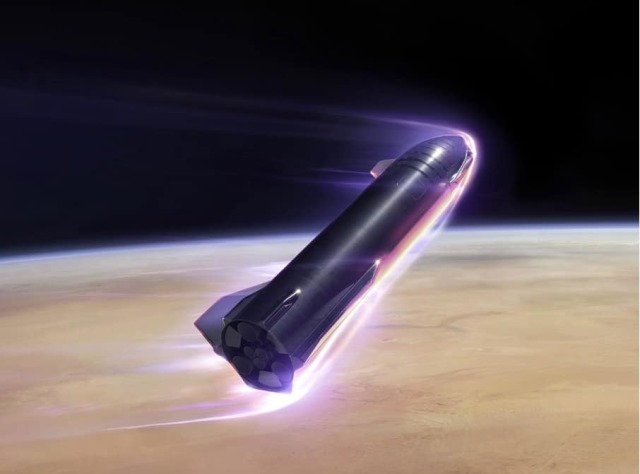 |
| Starship's entry into the atmosphere (here — Mars) with a large angle of attack. |
| Source: ©SpaceX |
At least, this is how the entry into the atmosphere is depicted on the SpaceX website: from parachuting to aerodynamic flight, with a stretched descent and gradual braking through the hypersonic range to supersonic speeds. Will Starship write out horizontal S-shaped figures like a "Shuttle", gradually reducing the speed in them? You can simply get into a turn (horizontal flight with a roll around the circumference) with the same overload as on the bends of the Shuttle flight figure; it will determine the intensity of braking. And then we calmly wait on the turn to reduce the speed to any required. At medium supersonic, we then exit the turn for a further decrease with the transition to subsonic speed. The supersonic stage will be more like the X-15 flights than a blunt-nosed "Shuttle", not adapted to supersonic speeds in any way.
Braking to the "knock" will happen quickly and without any special effects. Next, it is expected to move to the vertical drop that was worked out by previous Starship tests. The technique of such a landing has been demonstrated many times, and was analyzed in detail by us ( "Starship — flight test trail" ).
The piece of iron left over from the flight (if something remains, of course), plopped into the water, will be only the final impression of events, and with only some traces of what happened. With good telemetry, there is no need to restore events from the remaining design, everything that happened is already tightly measured in fact right during the flight, including current images from the right places inside and outside the device. The piece of iron is no longer needed here, except for memory.
Do you remember the tests of the famous hypersonic X-43A ? It was an advanced device that performed such flights for the first time, crossed the line, developed for the first time, and so on. So — they just threw him in the ocean, not bothering to search, because everything that happened was accurately measured and transmitted by telemetry to earth for registration (recording).
On the other hand, if the Starship is driven normally, not warped and has not lost its integrity, then this huge empty tank is unlikely to sink. He will not need to be searched for in the ocean, like a needle in a haystack, SpaceX has sufficient experience tracking the landing of its ships. It is unlikely to be a difficult task to lift Starship on board the ship — even with its large dimensions, but with empty tanks, it will not be too heavy. And, what the hell is not joking, then it will be possible to tinker with his recovery for the next flight. Only the events themselves will show how events will develop in this part.
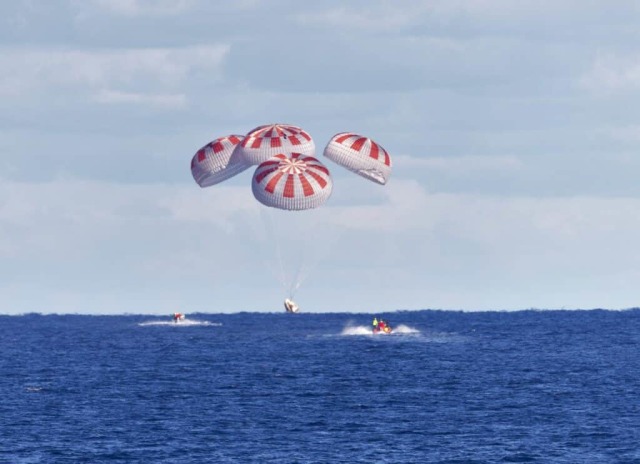 |
| The landing of the SpaceX Crew Dragon spacecraft with the crew in the Gulf of Mexico off the coast of the United States. |
| Source: ©NASA |
There is another important aspect of the splashdown. The landing of the Starship on the concrete platform has already been worked out to the "first successful" stage. But landing on Starship water, in any way, would be an interesting experiment.
Or, let's say the same emergency happens with Starship. Landing on the water will show what will happen next. From this it is possible to develop solutions for cases of flooding. And, perhaps, the first test flight, after the successful launch of Starship into orbit, further simulates and explores the situation of its fall into the water. Musk likes to condense events, and such a far-sighted option is quite in his spirit. And the recorded splashdown can be useful many times in the future.
Landing area and measuring capacities
Landing near Hawaii also has its own specific flavor. Re-entry into the atmosphere remains a completely untested stage of flight with maximum loads on the structure. In case of destruction, the debris will not harm the objects of the earth's surface, falling in a remote part of the ocean. Is it a coincidence that the area where warheads fall when launching intercontinental missiles from Russia at maximum range also lies near Hawaii, to the northwest of them? The trajectories during such launches pass first over the Kamchatka measuring complexes performing this combat work, and then in the close field of view of American measuring instruments.
In the western part of the Aleutian Arc on the American island of Shemiya there is a large measuring base built to participate in Soviet missile tests. Of course, data on the movement and signatures (radar features) of warheads were collected and are being collected by it not as part of a partnership, but in the intelligence interests of the United States. The main "eye" of the base is a huge radar station with a phased array antenna of 35 thousand elements called "Cobra DANE" (AN / FPS—108. COBRA DANE), undergoing periodic modernization.
She can also measure the movement of the Starship, whose flight will take place in her field of view and working range. RC-135S aircraft, specialized for telemetry work, can also take off from the airfield of the base. However, such use of military and intelligence federal equipment for the planned Starship test is only an assumption, not confirmed by direct information. But note that Musk's interaction with military missile ranges is a long—standing and fruitful one. It was not for nothing that he launched his first Falcon 1 space carrier from the island of Kwajalein Atoll — the main receiving (intercontinental missile warheads) test site of the United States, packed to the brim with measuring equipment (we talked about it in the material " Ballistics over Kwajalein "). There are also launch pads for various types of anti-missiles, which are part of the Ronald Reagan Missile Defense Test Complex.
The control and measuring complex, which is used for testing, is not widely publicized. But the more powerful the measurements (polling frequency and multichannel), more accurate and more accurate, the better. Therefore, measuring complexes of cosmodromes or rocket ranges are not comparable with simpler systems, and it would be reasonable to turn to them. At the same time, a successful launch into orbit will make the base in Texas also a spaceport. The launch and landing of the first stage (as well as the launch into orbit) should be observed by both the trajectorists and telemetry (our story about its work during tests is "The Case at the 14th measuring point "). Therefore, the starting position must be accompanied by measuring systems.
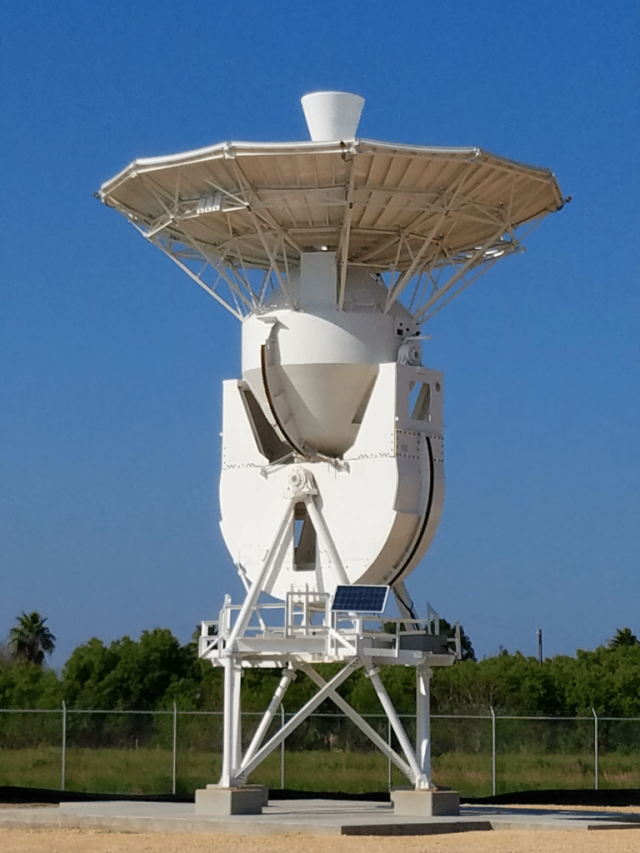 |
| A nine-meter S-band antenna of a radio telemetry system for tracking Shuttles at a small distance from the target (during launch and landing). Currently posted on Starbase. |
| Source: ©Wikimedia |
A few years ago, two nine-meter antennas of a radio telemetry station for tracking the launch and landing were transported to Starbase, which work during the launch of Crewed Dragon manned from Florida. There is no information about the means of trajectory measurements yet. It would be interesting to know which measuring technique provides the data of this launch. Moreover, the flights are planned to continue, with any outcome of the first test. Measurements are also necessary because they will be required by the Federal Aviation Agency FAA.
Landing Super Heavy: simplified first flight
After separation, the lower stage will describe in space a large aerospace loop of vertical development, repeating the landing loop of the Falcon 9 first stage used in dozens of launches. Although Super Heavy has never performed this loop before, a hundred successful landings of its younger sister from Falcon 9 indicates sufficient development of both ballistics and aerodynamics of such a loop. The same four lattice aerodynamic rudders at the top of the Super Heavy speak of the same control algorithm. The finish at the bottom of the loop will end with a landing on the water 32 kilometers from the shore and the launch and landing tower.
Checking in the first flight at once and the approach of the first stage for landing, and its landing is risky. In case of an emergency landing, the tower may be destroyed. Therefore, in the first flight, only the approach of the landing stage to the point with the specified coordinates will be checked. If this does not work, there will be a sufficient circle of water near the landing point to fall with deviations. And a successful approach to the desired point will open the way for a test landing on the tower. And although it is not planned for the first flight, let's take a look at the planned landing system on the MechaZilla tower, which will become a launch and landing tower, the only one of its kind.
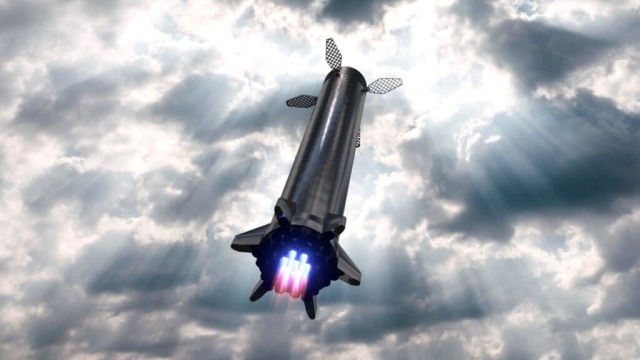 |
| Super Heavy approach for landing. |
| Source: ©SpaceX |
On the one hand, this landing scheme is unusual and has never been implemented before in the form of a technical system and real landings. On the other hand, you can't deny the Mask the ability to create a new type of landing systems. Recently, the first stage of the Falcon 9 stepped over the hundredth successful landing in a row. Before the first vertical landing on the opening supports, skepticism was more than enough; this is healthy skepticism, and we all need it. Now the situation is similar, and there is little data about the landing of the first stage, except for the general features of the MechaZilla tower and cartoons with it. As well as about the remaining fuel in the stage at the time of landing, and the speed when touching the supports. The whole dynamics of the landing is unknown.
However, there is nothing impossible in the Super Heavy landing scheme, it is mainly a matter of controlling the movement of the stage. With a certain accuracy, the stage could hang in the air for the time of bringing the supports. But a small error in control, which will always be, can give a small residual speed with which the step will descend on the supports. And here the question arises: what ensures the accuracy of the spatial position of the stage? Orientation in space and stabilization at a low pre—landing speed near the tower are certainly reactive systems that need to work out commands energetically and quickly, with good traction.
You can control the position of the center of mass and the axis of the rocket relative to the tower and its legs using a local system mounted on the tower and stage. For example, a thousand sensors such as parking sensors on the launch and landing tower will give an accurate, up to a centimeter, impression of the position of the stage relative to the tower. Next, solutions are needed for the accuracy of landing thrust control and the operation of contact sensors with the measurement of the Super Heavy increasing pressure on the tower supports until the dynamics are completely attenuated.
The suspension of the rocket on supports for the upper part is practiced for mine-based ICBMs. More precisely, a capsule with a rocket is suspended by the protrusions on the upper part, resting on a power ring at the top of the shaft. There is a free space of about a meter between the shaft and the suspended capsule everywhere, both from the sides and from the bottom. With a close ground (or in the ground) nuclear explosion, a seismic wave will cause sharp fluctuations in the ground with a large displacement amplitude, up to half a meter or more. For these half a meter, the ground shifts at a high speed. So that such an irresistible blow of a seismic hammer does not crush the rocket, it is removed from the walls and bottom of the mine cup.
But the shock wave can be reflected earlier and lower from more durable granites, and come to the mine obliquely from below. There will also be a vertical push of the soil, and it will be transmitted to the mine support ring. It is made in such a way that it dampens the shock within certain limits. A small push can be passed onto a suspended capsule with a rocket; but what kind? His assessment is the same task of determining the permissible landing speed for the stage: with what force and speed the stage will poke into the tower supports without consequences for both.
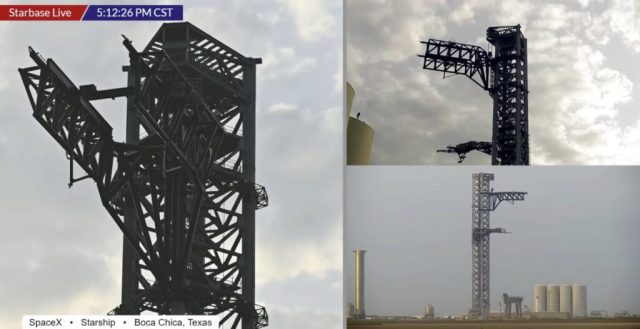 |
| MechaZilla launch and landing tower. |
| Source: ©NASA |
Therefore, landing on the supports, the stage (as well as the capsule with the mine ICBM) will experience shaking, and with it a tensile load. If this push had hit the bottom of the stage, the load would have been compressive — like the first stage of the Falcon 9, which has landing supports at the bottom. Why did they choose hanging by the upper part for Super Heavy? How is a tensile load better than a compressive one?
It is known that when compressed, the structure loses stability with much less force than when stretched. And although the take-off weight, its own and Starship, and the growing overloads load the stage with a fair amount of compression, landing an empty stage may have its moments. For example, in a filled tank, the weight of fuel creates pressure at the bottom, stretching the tank to the sides and increasing its stability, like a filled bag or an inflated balloon. And with a landing push with a minimum of fuel, the compression of the wall (without reinforcement from the inside by fuel pressure) may approach the crushing one. However, these are only versions; the exact justifications for choosing such a design still remain within the walls of SpaceX.
Accident rate of super-heavy vehicles
Further tests will show how the first landing will turn out according to this scheme, and how it will end. If, of course, it comes to them. The first test launch is always terra incognita. Even tests of new modifications of the rocket that flew earlier. A new architecture and scale space system will also be tested here.
The accident rate of superheavy rockets is low, probably due to their high cost and higher costs for pre-flight checks. All flights of the American Saturn-V became successful, as well as the Soviet Energia, and five Falcon Heavy flights today. And all four flights of the Soviet N-1 became emergency, the haste of the political race in space affected.
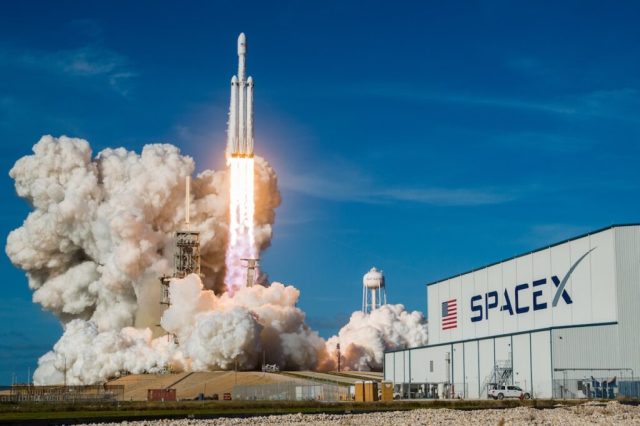 |
| Launch of the Falcon Heavy superheavy rocket from the LC-39A launch complex, Kennedy Space Center, Florida, USA. |
| Source: ©SpaceX |
Musk is not in the race, he just doesn't want to waste time. And the flight tests of Starship differ from all previous superheavy systems by a series of separate tests of the second stage of the complex. In them, Starship not only learned how to land, but also fully harvested its emergency crop. Blurring the boundaries of the concept of "emergency flight tests", which previously referred only to the flight of a superheavy rocket entirely.
Knowing Musk's love for the empirical path and moving forward through crash tests, is it possible to assume the degree of reliability of preparation for the first flight test of the entire rocket? It is unlikely that a bigger crash test is being deliberately prepared this time. The details of the position of the FAA giving permission for testing are also unknown. For any accidents, it forces "a lot of work to be done to identify and prevent". At the same time, even during an emergency start-up, powerful multi-channel telemetry will help to understand in detail where and how the failure tree developed, and improve the following design or control algorithms.
Musk has the experience of creating an accident-free (for those who continue to fly, always "accident-free") superheavy rocket, his Falcon Heavy did without crash tests. Successful tests are the best, fastest and most economical way to create equipment. Therefore, with Starship, Musk will most likely try to repeat his successful experience, if his new rocket with a more complex flight allows it. The first launch may still be postponed more than once, but there is no doubt that it will take place. And, perhaps, very soon many of our questions will be answered. We'll see what they will be like after the flight.
Addendum 1
Let's estimate, even from the meager information of the flight scheme, as real ballistics, what the turn will be, complete or incomplete. The coordinates of Starbase are 25°59'29" north latitude 97°11'01" west longitude. The coordinates of Kauai are 22°4'12" north latitude 159°30'0" west longitude. Since the inclination of the orbit will be small, it is possible, for example, to estimate by longitude. The difference in the longitude of the start and the goal is, as we can see, 62 degrees. At launch, the orbit is fixed in space relative to the stars, as if it is filled with concrete; it practically does not change its position in space during the first few revolutions. The earth beneath it rotates with its daily rotation.
Turnover per day is 15 degrees per hour. A full orbit of a satellite in low orbit takes an hour and a half (roughly). So, during this revolution, the Earth will scroll under the orbit by 22.5 degrees. And it will reduce the longitude difference between the start and the target by the same amount — in other words, it will drag the point of the future fall to the east by 22.5 degrees in an hour and a half of flight time. The rest of the difference is 62 – 22.5 = 39.5 degrees, let's take 40 degrees (taking into account the short flight of 100 kilometers to Kauai, it's almost a degree), the satellite itself should close its orbit with its movement until the closure of the full spatial orbit. And Starship will not fly these 40 degrees: it will eventually pass not 360 degrees of longitude, as in any closed loop, but 40 degrees less. This is a short flight in longitude to a full 40/360 turn, or one ninth of a turn.
In addition, the orbit does not start at the start. Usually, the entry into the reference orbit takes place at an orthodromic distance from the start of the order of 300-400 kilometers. This is with a slight inclination of the orbit of three to four degrees, that is, another three degrees without orbital flight. Total 43/360 = 0.12, one-eighth of the total turnover is not present. It can also be taken into account that the finish does not end at orbital speed. The path in the atmosphere will be hundreds of kilometers, like the Shuttle, which is still minus degrees from orbit. Further clarifications and corrections begin to multiply, but the approximate conclusion is clear: there is no complete revolution in orbit. At the same time, it is clear that the orbital flight will occupy the main part of the orbit, allowing to work out the functioning in orbit.
Addendum 2
Among all four trouble-free superheavy rockets, Saturn-5 has more flights, there are 12 of them, including the first test ones. But in more detail, the Saturn-5 tested the first two stages in its composition. And the third one has already been flown in three successful launches of Saturn-1B over the previous year as its second stage. In the second stage of the Saturn-5 there were also flying engines from this stage J-2. The body of the second stage itself is not so difficult to design, the approach and materials are flown at the third stage. The more successfully flown, the better. And it is not difficult to make new enlarged barrels for fuel. Therefore, the main object of testing was the first stage, with other fuel and non-flying engines.
The situation is similar with Starship, with the degree of circumnavigation of the second stage, the ship itself. Its engines have been tested in flight, as well as landing from a height of 10 kilometers. The first stage is being tested, but its trajectory for landing and the aerodynamic control scheme have been worked out by Falcon 9. The ratio flew / did not fly, as part of the design and flight schemes (if you set its rule and accurately calculate it) lies in close values for Saturn-5 and Starship.
The second flight of Saturn 5, the last unmanned Apollo 6, was on the verge of a complete accident. The first stage was shaken longitudinally with the output of shaking beyond the permissible values. This pretty loosened or turned the stuffing of the second stage, which began to fail during operation. First, two engines (out of five) failed, then the third dropped the thrust by two and a half tons. As a result, the Apollo did not reach the target highly elliptical orbit, along which it was then supposed to descend with acceleration and acceleration of the engine to enter the atmosphere at the second cosmic speed.
It was the exit from the "high hill" that allowed us to accelerate to such a speed. But during the launch, they only reached the low reference orbit. The engine of the third stage for the exit to the hill did not turn on (failure), the Apollo with its engine accelerated to an altitude of 22 thousand kilometers, and completed some flight program, but did not reach the planned speed of entry into the atmosphere. Had the shaking lasted for a couple of tens of seconds (each subsequent second of shaking causes more damage due to the growth of mobility of structural elements) or to grow a little stronger, and it would not have been possible to enter orbit.
And there was no shaking in the first descent. Now Super Heavy will have a check for such situations. In flight, something always goes wrong, whether it will develop to serious. To perceive the trouble-free "Saturn—5" is in the right perspective - taking into account the degree of circumnavigation of the rocket elements in its first launch. And taking into account the pre-emergency flight situations that led to a serious redrawing of the flight program and the failure to achieve flight goals.
